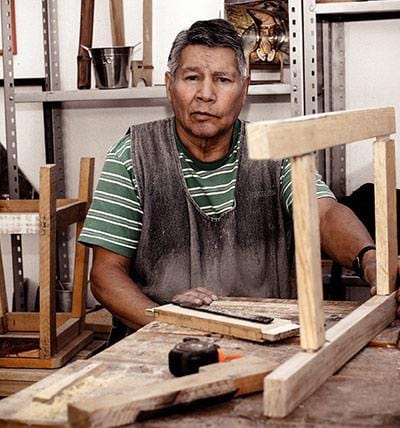Creating wooden toys for your children can be a great way to provide hours of fun and entertainment. However, when it comes to painting those toys, it is important to use the safest paint available to ensure your children are not exposed to any toxins.
Fortunately, there are several paints on the market that are specifically designed to be safe for use on wooden toys. In this article, we’ll take a look at the best options to ensure your kids are having fun without any potential health risks.
Understanding the Safety Of Different Paints For Wooden Toys
The safety of different paints for popular wooden toys is important when selecting the materials for a toy. Paints may contain chemicals or dyes that could be harmful to children or have other safety risks.
Paints may also contain solvents that can produce dangerous vapors or fumes. When selecting paint for wooden toys, look for products that are labeled non-toxic, low-VOC, or certified as safe for children.
Natural and eco-friendly paints are also preferable, as they are often free from synthetic. Additionally, it is important to read the manufacturer's instructions for the proper use and safety precautions.
How to Choose Safe Paint for a Wooden Toy?
When choosing paint for wooden toys, safety is of utmost importance. There are a variety of paints available, each with its set of benefits and drawbacks. It is important to understand the safety of the different paints before selecting one for use on wooden toys.

The type of paint chosen for wooden toys should be based on the desired finish, ease of cleanup, and safety. Look for a paint that is non-toxic and approved by a third-party organization such as ASTM International (American Society for Testing and Materials). Choose water-based paints over oil-based ones, as oil-based paints may contain harmful solvents to a certain degree. Check the label for any warnings or cautions about the paint, such as “keep out of reach of children”. Make sure the paint is intended for use on wooden toys. Some paints are only suitable for use on other materials such as metal or plastic. Avoid paints that contain lead, mercury, or other toxic metals. If you’re unsure, contact the manufacturer or a paint specialist for advice.
Types of Safe Paints for Wooden Toys
Natural Paints
Studies have shown that children's toys can come with hazardous chemicals that can be harmful to their health. Therefore, parents should be aware of the safest paint to use on wooden toys for their little ones. Natural paints are an excellent option for any parent looking to craft a safe wooden toy for their child. They contain no toxic chemicals, unlike traditional paints, and can provide a non-toxic alternative for parents. These paints are often made with plant-based ingredients and come in a variety of safe and vibrant colors. Usually, they are made from a combination of water, vegetable oil, and eco-friendly dyes, and they provide a safe, non-toxic coating for wooden toys.
Non-Toxic Paints
To ensure that the paint used on wooden toys for children is non-toxic, the best option is to use paints that are certified as non-toxic. Non-toxic paints are made with ingredients that are not known to be harmful to people or the environment. These paints may include natural dyes, water-based acrylics, and even vegetable-based oils.
Water-based paints are considered the safest option for wooden toys, as they are non-toxic and can be easily cleaned with soap and water. These paints are also generally inexpensive and dry quickly. However, water-based paints can be easily scratched or damaged if not properly sealed and protected.
Oil-based paints are also commonly used on wooden toys, however, they are more toxic than water-based paints and can be difficult to clean up. Oil-based paints are also known to produce a stronger odor, which can irritate users.
Acrylic paints are the most durable type of paint available for wooden toys and can provide a glossy finish. However, acrylic paints are not recommended for use on wooden toys due to their toxicity and the difficulty of cleaning up if they are spilled.
Latex paints are considered the safest option when painting wooden toys, as they are non-toxic, easy to clean up, and can provide a glossy finish. But latex paints are not as durable as other types of paints and can easily be scratched or damaged.
Hypoallergenic Paints
One of the safest paint options available is hypoallergenic paint. Hypoallergenic paint is designed specifically to be non-toxic and free of chemicals or other irritants that can cause allergies or skin irritation. This type of paint also has a low Volatile Organic Compound (VOC) level, which means that it is less likely to emit fumes or odors that can be harmful to small children. Hypoallergenic paint is available in a variety of colors, allowing you to customize wooden toys.
Regulations for Paints Used On Toys
If the wrong kind of paint is used on wooden toys, children can be exposed to dangerous chemicals and toxins. That’s why it’s so important to select the safest paint for wooden toys. When it comes to paints used on wooden toys, the regulations are strict.

All paints must be non-toxic, lead-free, and phthalates-free, and meet the requirements of the Toy Safety Directive. This means that any paints used on toys must pass a rigorous testing process to ensure their safety for children.
Labeling Requirements for Safe Paint
Children often put their toys in their mouths, so it is essential to make sure the paint used on wooden toys for children is safe.
When choosing what type of paint to use, look for paints labeled “nontoxic” or “child safe.” These paints are made with non-toxic ingredients that are safe for children.
Safety Testing Requirements
When it comes to creating wooden toys for children, safety is the number one priority. After all, you want to make sure the toys you create are safe and non-toxic for kids to enjoy. When looking for safe paint to use on wooden toys, you must ensure the paint meets all safety requirements set by the Environmental Protection Agency (EPA). The EPA regulates the use of paints and coatings that contain hazardous substances and volatile organic compounds (VOCs). As a result, these regulations must be met before using any paint on wooden toys.
How to Test If the Paint is Safe to Use On Wooden Toys?
Purchase a non-toxic paint that is specifically designed for use on children’s wooden toys. Follow the instructions on the package to ensure that the paint is safe for use on wooden toys. Apply a small amount of the paint to an inconspicuous area of the toy, such as the underside. Let the paint dry for 24 hours and check for any signs of irritation or reactions on the skin. If there are no reactions, the paint is safe for use.
Final Thoughts
In conclusion, when it comes to the safest type of paint to use on wooden toys for small children, it is best to use non-toxic and water-based paint. You should always research the product and make sure it is certified as non-toxic before use.
Other important factors to consider include the wood sealant, shelf life, and general maintenance of the toy. Finally, make sure you follow safety precautions and always supervise children during painting activities.
Commonly Asked Questions
What is the best place to buy safe paints for wooden toys?
The best place to buy them would be online stores that specialize in products designed for safe toy-making.

They typically offer non-toxic to water-based paint types that are suitable for use on wood and other materials.
They also usually carry a wide range of colors and finishes to choose from.
Additionally, many websites also offer free shipping and helpful customer service.
Is it safe for newborns to use wooden toys?
It is generally safe to use wood toys for newborns, under certain conditions.
As long as the wood used is untreated and non-toxic, and the toys don't contain any metal parts, pieces, or other small items that could be swallowed or inhaled, they should be safe for use.
However, it's important to always closely inspect wooden toys for any signs of splintering, warping, or peeling paint, to ensure that such items are safe for use by babies.
Also, it's always wise to thoroughly clean and sterilize any toy for your child, including wooden ones.
How to choose the right wood wax products for toys?
It is best to select a wax formulated for children’s toys. Look for non-toxic ingredients and those that are designed to protect the wood from wear and tear. Additionally, check the label for application instructions, as some waxes may require multiple layers to achieve the desired protection.
What is the best brand of wood toys for toddlers?
Some of the top brands include Hape, Melissa & Doug, Vilac, Plan Toys, and Edushape. Each of these brands offers a variety of different toys made of quality wood that can help toddlers learn and develop, including puzzles, building blocks, shape sorters, and more.
ABOUT THE AUTHOR
Aleksandra Djurdjevic
Senior Content Creator
Aleksandra Djurdjevic is a senior writer and editor, covering jewelry, accessories, and trends. She’s also works with services, home décor. She has previously worked as ESL teacher for English Tochka. Aleksandra graduated from the Comparative Literature department at the Faculty of Philosophy in Serbia. Aleksandra’s love for the environment, crafts and natural products over the years helps her continue to be a top expert at Wooden Earth.






